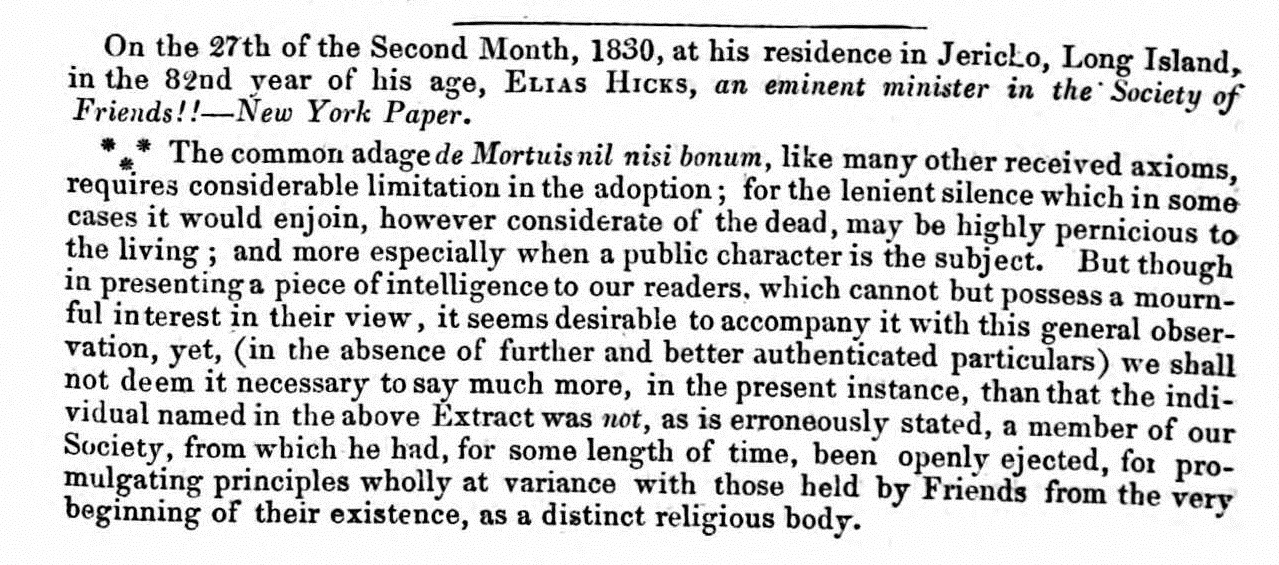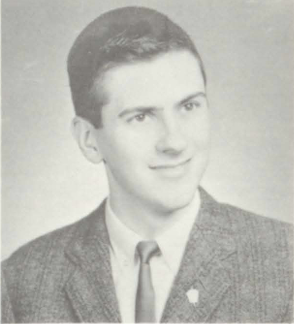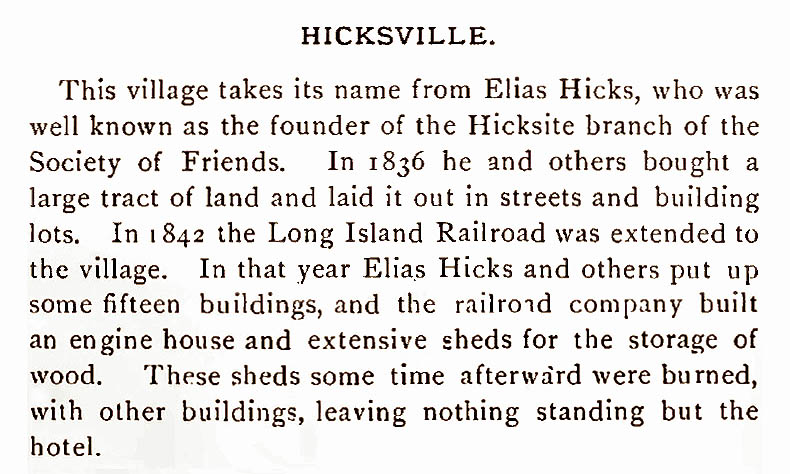
Introduction
I spent much of my retirement researching and writing about the events and facts that wove together to tell Hicksville’s history. Here, for the first time, I have tried to erase some legendary events from the faulty memory of the village’s earliest days – BECAUSE THEY NEVER HAPPENED.
The Fable Begins
In 1882, a History of Queens County, 1683-1882 was published, celebrating in more than 600 glorious pages the story of every village and town that lay between Kings and Suffolk Counties. The Chapter on Hicksville may be unique among the book’s contents, for the account of that village’s founding may be the only one in the entire book that bears almost no connection with reality:
Where to begin? This is fable, not history. In reality, the village was named after Quaker land speculator and LIRR President Valentine Hicks, not itinerant Quaker preacher Elias Hicks. The latter did NOT lay out the village’s streets in 1836, having died in 1830. The railroad reached the village-to-be in 1837, not in 1842, and although the LIRR then erected a number of railroad structures, there seems to be no evidence that Valentine Hicks and his cohorts did anything to develop the place they had named “Hicksville.” Their properties lay fallow for years, waiting for resale until the railroad had made large-scale farming in Hicksville feasible. Only then were the speculators’ properties re-sold (at significant profit) as “virgin farmland” to newcomers who would farm it hard and raise profitable crops that were shipped by train to the markets of New York. There seems to be no contemporary evidence or record of a devastating fire.
The single element of truth in the fable is that when German immigrants first arrived at the Hicksville depot, the Grand Central Hotel stood nearby, a solitary retreat built to invite city dwellers to hunt in the wild, wooded Long Island plains.
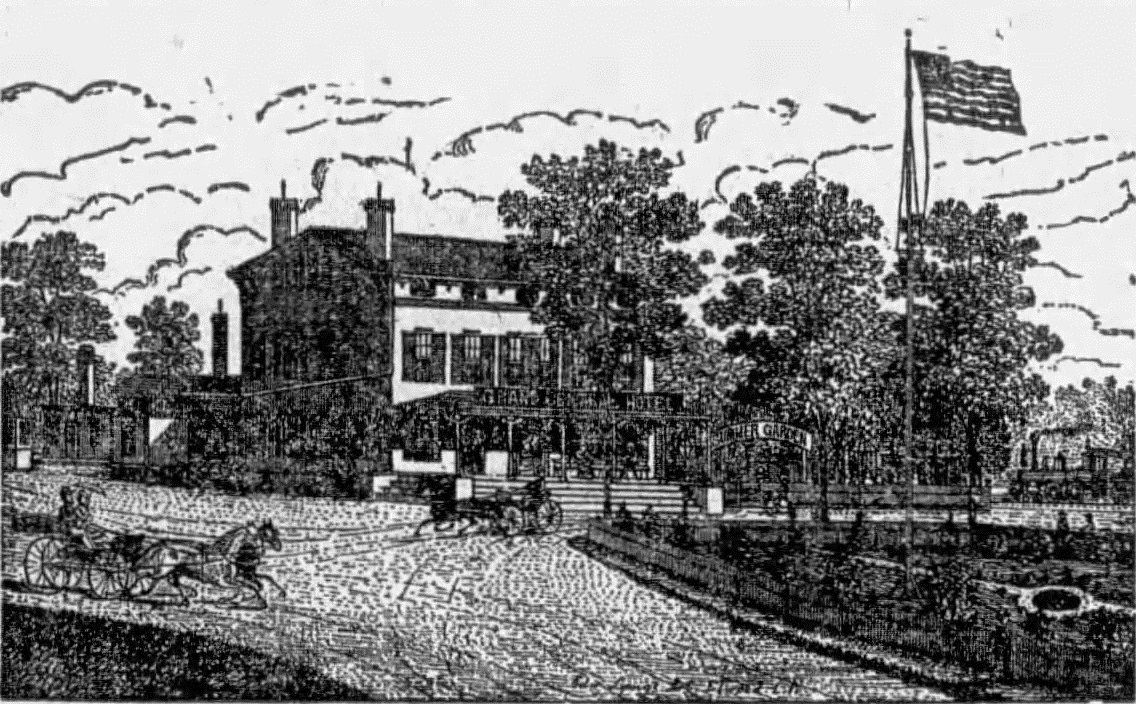 old-time view of Grand Central Hotel reprinted in Brooklyn Daily Times for July 23, 1890
old-time view of Grand Central Hotel reprinted in Brooklyn Daily Times for July 23, 1890
What Do Richard and Anne Evers Say?
The Evers’ marvelous Images of America book is an enigma. It quite correctly rejects the idea that Elias Hicks founded Hicksville, and it embraces the notion that Valentine Hicks and his cronies diverted the LIRR’s route so that they could enrich themselves through land speculation. It further points out that Jericho served as a retail hub for the earliest settlers of Hicksville, indirectly supporting the idea that the original Quaker land speculators never developed their Hicksville properties.
And yet, the authors devote precious space in their little book to Elias Hicks, as if he had played some crucial role in the founding of Hicksville – a suggestion that I reject. In the decades before Hicksville came to be, the Hempstead-born preacher (who considered Westbury his true home) found his calling, and he traveled constantly. He spent years preaching to slave-owning Quaker pioneers on the Pennsylvania and Ohio frontiers, quite possibly crossing paths with Daniel Boone. He eventually devised his “Hicksite” religious ideas, which caused such a schism within Quakerism that his very presence was unwelcome in many traditional Quaker communities. On one of his rare later returns to Long Island, he and his followers in Westbury freed their household slaves, bolstering the community of free blacks who lived just west of Hicksville. There’s a lot to say about Elias Hicks, but the Evers don’t say it. Instead, they inject pastoral pictures of Jericho (including his home there – actually, it’s his wife’s family’s home) as if the gloss of those images might suggest that Hicksville had an early Quaker history. It didn’t.
Ariel and Post Boy
More puzzling to me is their choice to repeat and amplify the bogus idea of the devastating fire. In a photo caption, they knot together two unrelated things, stating, “Hicksville’s first station and roundhouse burned up and two DeWitt Clinton engines, the Ariel and the Postboy, [sic] collided.” Let’s untangle this confusion, which hints that in the mayhem of a great Hicksville conflagration, the LIRR’s original two engines collided.
There was a collision between the two locomotives, which achieved notoriety only because it was a novel event. Before it happened, the public did not realize that the flame-spewing engines of the day might ever crash (the phrase “train wreck” had not yet earned its blood-soaked meaning). In fact, the mishap was minor: one locomotive suffered a broken crankshaft, which soon was replaced. The most important outcome of the incident was the realization that the railroad should keep some spare engines on hand.
Ziel and Foster’s book Steel Rails to the Sunrise includes a complete historical roster of LIRR locomotives, which helps us put the famous collision into insignificant perspective. Ariel was first put into service in 1835 and was not retired until twenty years later. Post Boy entered service in 1836, and it went on to serve the railroad much longer, probably being relegated to less demanding roles as the years passed. It was not retired until 1881. Neither locomotive’s career was seriously affected by their now-famous minor collision. Why did the Evers append the gratuitous mention of a fender-bender to the rumor of a supposedly calamitous fire at Hicksville?
What Roundhouse?
The original 1882 Fable discusses losing an “engine house” to fire. In contrast, the Evers use the word “roundhouse.” Just what is a roundhouse? Let’s take a look.
 from Long Island Rail Road Turntables, by David D. Morrison
from Long Island Rail Road Turntables, by David D. Morrison
A roundhouse is an adjunct to a turntable, in the way that a garage is an adjunct to a driveway. The difference is that a roundhouse is a curved set of service bays for many locomotives that share one driveway. Each bay’s track can connect to a rotating length of track on a turntable. In this photograph, the roundhouse’s “service bays” fan out from the open “moat” of the turntable pit, in which the pivoting turntable “bridge” is clearly visible.
According to David D. Morrison, Historian of the LIRR for the National Railway Historical Society, the records and artifacts of the railroad do not indicate that any turntable was ever built at Hicksville. This makes perfect sense; the railroad had no need for a turntable there. But even had it wanted to build one at that time, it could not have: the LIRR only mastered the requisite know-how to build its first turntable years after the mythical fire supposedly destroyed Hicksville.
Hicksville never had a turntable. Ergo, it never had a roundhouse. We can never know the reason(s) why Richard and Anne Evers came to believe otherwise.
Hicksville Never Burned to the Ground
In theory, it can be very difficult to prove that a given thing never happened.
I am confident, however, that there never was a Great Fire of Hicksville – because if it HAD occurred per the Fable, it could only have happened after the railroad reached Hicksville (March 1837) and before the first German immigrants arrived (i.e., about July 1849). One can easily review the records of historical events that cover those twelve years.
As the LIRR approached its new “Hicksville” terminus in 1837, weekly news reports described both the technical progress and the plans to celebrate the event publicly. The “Big Day” occurred without incident. Please note that the news reports of 1837 in no way imply that there was ANYTHING at Hicksville that could burn down, let alone the “fifteen buildings” of the Fable. The place is not described at that time as a village or town but rather as a mere geometric “point just south of the village [of Jericho].”
 Long Island Star 2 February 1837
Long Island Star 2 February 1837
This may be the first time that the new village’s name of Hicksville ever appears in print; hence, the description tells readers that it is not Jericho but a new place.From that day forward, the newspapers immediately began publishing schedules for the railroad and the stage lines that served its stations. Occasional minor delays were duly reported, but from 1837 into the 1840s there were no reports of any significant fire at Hicksville. That finally changed after seven years.
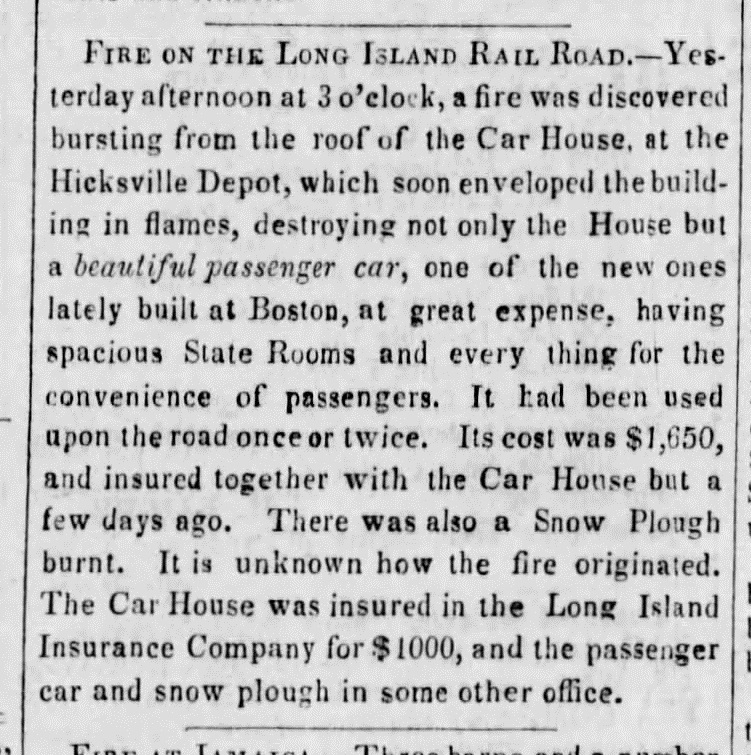 Brooklyn Evening Star for July 20, 1844Although the financial loss was newsworthy, only one building burned, and it contained only one railroad car. The fire did spread to a wooden snow plow, which likely had been parked outside for the summer, next to the Car House. This was no widespread disaster.
Brooklyn Evening Star for July 20, 1844Although the financial loss was newsworthy, only one building burned, and it contained only one railroad car. The fire did spread to a wooden snow plow, which likely had been parked outside for the summer, next to the Car House. This was no widespread disaster.
No significant Hicksville fire was reported again in the newspaper archives until the Civil War era when local LIRR agent Henry Gould locked up the station for the night and accidentally left an oil lamp burning. To his dismay, the lamp eventually exploded, and the station burned to the ground. Again, only one building was lost.
Where There's Fog There's Fire?
I must confess that some gaps exist in the newspaper archives of the 1840s. However, any uncertainty seems to be eliminated by various surviving retrospective articles about Hicksville – none of which offer any facts to support the idea that the newborn village had any wooden structures to burn until after the original Quaker speculators sold their properties. It seems clear that the Fable of 1882 never had any basis – and yet it was accepted, repeated, and embellished as part of the fog of Hicksville’s past.
When historians fail to think critically, they may accept mere fog as smoke, and come to believe there once was a fire.
Bibliography
The searchable Collection of Public Newspapers for the years 1809-1899 at the Brooklyn Public Library was an invaluable historical resource for researching this topic. Specific sources are noted in the body of this article.
Steel Rails to the Sunrise: The Long Island Rail Road, by Ron Ziel and George Foster, again has proved its value by distilling and extending the research of late Long Island historian Vincent F. Seyfried through a rich, well-illustrated, and concise text.
David D. Morrison’s monograph Long Island Railroad Turntables was an important source of information. It can be viewed online at http://www.trainsarefun.com/lirr/turntables/turntable.htm
The Wikipedia Entry for Elias Hicks is both fascinating and enlightening.
Also enlightening are articles published in 1830 in the Philadelphia Society of Friends (i.e., Quaker) publication The Friend, or Advocate of Truth, written subsequent to the death of Elias Hicks. The following is the Editors’ response to a newspaper report of his passing, in which they feel compelled to “speak ill of the dead” – because despite his being a sincerely reverent man, Elias Hicks had willingly transgressed fundamental religious doctrine, and thus he no longer deserved – even in death -- to be called a Quaker.
